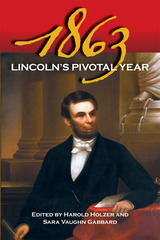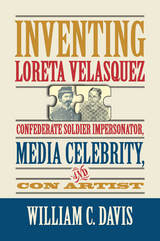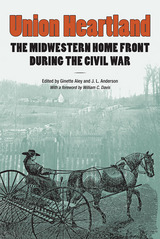3 books by Davis, William C.

1863
Lincoln's Pivotal Year
Edited by Harold Holzer and Sara Vaughn Gabbard
Southern Illinois University Press, 2013
Only hours into the new year of 1863, Abraham Lincoln performed perhaps his most famous action as president by signing the Emancipation Proclamation. Rather than remaining the highlight of the coming months, however, this monumental act marked only the beginning of the most pivotal year of Lincoln’s presidency and the most revolutionary twelve months of the entire Civil War. In recognition of the sesquicentennial of this tumultuous time, prominent Civil War scholars explore the events and personalities that dominated 1863 in this enlightening volume, providing a unique historical perspective on a critical period in American history.
Several defining moments of Lincoln’s presidency took place in 1863, including the most titanic battle ever to shake the American continent, which soon inspired the most famous presidential speech in American history. The ten essays in this book explore the year’s important events and developments, including the response to the signing of the Emancipation Proclamation; the battles of Gettysburg and Vicksburg, and other less-well-known confrontations; the New York City draft riots; several constitutional issues involving the war powers of President Lincoln; and the Gettysburg Address and its continued impact on American thought. Other topics include the adaptation of photography for war coverage; the critical use of images; the military role of the navy; and Lincoln’s family life during this fiery trial.
With an informative introduction by noted Lincoln scholar Harold Holzer and a chronology that places the high-profile events of 1863 in context with cultural and domestic policy advances of the day, this remarkable compendium opens a window into a year that proved decisive not only for the Civil War and Lincoln’s presidency but also for the entire course of American history.
[more]

Inventing Loreta Velasquez
Confederate Soldier Impersonator, Media Celebrity, and Con Artist
William C. Davis
Southern Illinois University Press, 2016
She went by many names—Mary Ann Keith, Ann Williams, Lauretta Williams, and more—but history knows her best as Loreta Janeta Velasquez, a woman who claimed to have posed as a man to fight for the Confederacy. In Inventing Loreta Velasquez, acclaimed historian William C. Davis delves into the life of one of America’s early celebrities, peeling back the myths she herself created to reveal a startling and even more implausible reality.
This groundbreaking biography reveals a woman quite different from the public persona she promoted. In her bestselling memoir, The Woman in Battle, Velasquez claimed she was an emphatic Confederate patriot, but in fact she never saw combat. Instead, during the war she manufactured bullets for the Union and persuaded her Confederate husband to desert the Army.
After the Civil War ended, she wore many masks, masterminding ambitious confidence schemes worth millions, such as creating a phony mining company, conning North Carolina residents to back her financially in a fake immigration scheme, and attracting investors to build a railroad across western Mexico. With various husbands, Velasquez sought her fortune both in the American West and in the Klondike, though her endeavors cost one husband his life. She also became a social reformer advocating on behalf of better prison conditions, the Cuban revolt against Spain, and the plight of Cuban refugees. Further, Velasquez was one of the first women to venture into journalism and presidential politics. Always a sensational press favorite, she displayed throughout her life an uncanny ability to manipulate popular media and to benefit from her fame in a way that prefigured celebrities of our own time, including using her testimony in a Congressional inquiry about Civil War counterfeiting as a means of promoting her latest business ventures.
So little has been known of Velasquez’s real life that some postmodern scholars have glorified her as a “woman warrior” and used her as an example in cross-gender issues and arguments concerning Hispanic nationalism. Davis firmly refutes these notions by bringing the historical Velasquez to the surface. The genuine story of Velasquez’s life is far more interesting than misguided interpretations and her own fanciful inventions.
This groundbreaking biography reveals a woman quite different from the public persona she promoted. In her bestselling memoir, The Woman in Battle, Velasquez claimed she was an emphatic Confederate patriot, but in fact she never saw combat. Instead, during the war she manufactured bullets for the Union and persuaded her Confederate husband to desert the Army.
After the Civil War ended, she wore many masks, masterminding ambitious confidence schemes worth millions, such as creating a phony mining company, conning North Carolina residents to back her financially in a fake immigration scheme, and attracting investors to build a railroad across western Mexico. With various husbands, Velasquez sought her fortune both in the American West and in the Klondike, though her endeavors cost one husband his life. She also became a social reformer advocating on behalf of better prison conditions, the Cuban revolt against Spain, and the plight of Cuban refugees. Further, Velasquez was one of the first women to venture into journalism and presidential politics. Always a sensational press favorite, she displayed throughout her life an uncanny ability to manipulate popular media and to benefit from her fame in a way that prefigured celebrities of our own time, including using her testimony in a Congressional inquiry about Civil War counterfeiting as a means of promoting her latest business ventures.
So little has been known of Velasquez’s real life that some postmodern scholars have glorified her as a “woman warrior” and used her as an example in cross-gender issues and arguments concerning Hispanic nationalism. Davis firmly refutes these notions by bringing the historical Velasquez to the surface. The genuine story of Velasquez’s life is far more interesting than misguided interpretations and her own fanciful inventions.
[more]

Union Heartland
The Midwestern Home Front during the Civil War
Edited by Ginette Aley and J. L. Anderson, with a foreword by William C. Davis
Southern Illinois University Press, 2013
The Civil War has historically been viewed somewhat simplistically as a battle between the North and the South. Southern historians have broadened this viewpoint by revealing the “many Souths” that made up the Confederacy, but the “North” has remained largely undifferentiated as a geopolitical term. In this welcome collection, seven Civil War scholars offer a unique regional perspective on the Civil War by examining how a specific group of Northerners—Midwesterners, known as Westerners and Middle Westerners during the 1860s—experienced the war on the home front.
Much of the intensifying political and ideological turmoil of the 1850s played out in the Midwest and instilled in its people a powerful sense of connection to this important drama. The 1850 federal Fugitive Slave Law and highly visible efforts to recapture former bondsmen and women who had escaped; underground railroad “stations” and supporters throughout the region; publication of Ohioan Harriet Beecher Stowe’s widely-influential and best-selling Uncle Tom’s Cabin; the controversial Kansas-Nebraska Act of 1854; the murderous abolitionist John Brown, who gained notoriety and hero status attacking proslavery advocates in Kansas; the emergence of the Republican Party and Illinoisan Abraham Lincoln—all placed the Midwest at the center of the rising sectional tensions.
From the exploitation of Confederate prisoners in Ohio to wartime college enrollment in Michigan, these essays reveal how Midwestern men, women, families, and communities became engaged in myriad war-related activities and support. Agriculture figures prominently in the collection, with several scholars examining the agricultural power of the region and the impact of the war on farming, farm families, and farm women. Contributors also consider student debates and reactions to questions of patriotism, the effect of the war on military families’ relationships, issues of women’s loyalty and deference to male authority, as well as the treatment of political dissent and dissenters.
Bringing together an assortment of home front topics from a variety of fresh perspectives, this collection offers a view of the Civil War that is unabashedly Midwestern.
[more]
READERS
Browse our collection.
PUBLISHERS
See BiblioVault's publisher services.
STUDENT SERVICES
Files for college accessibility offices.
UChicago Accessibility Resources
home | accessibility | search | about | contact us
BiblioVault ® 2001 - 2024
The University of Chicago Press









